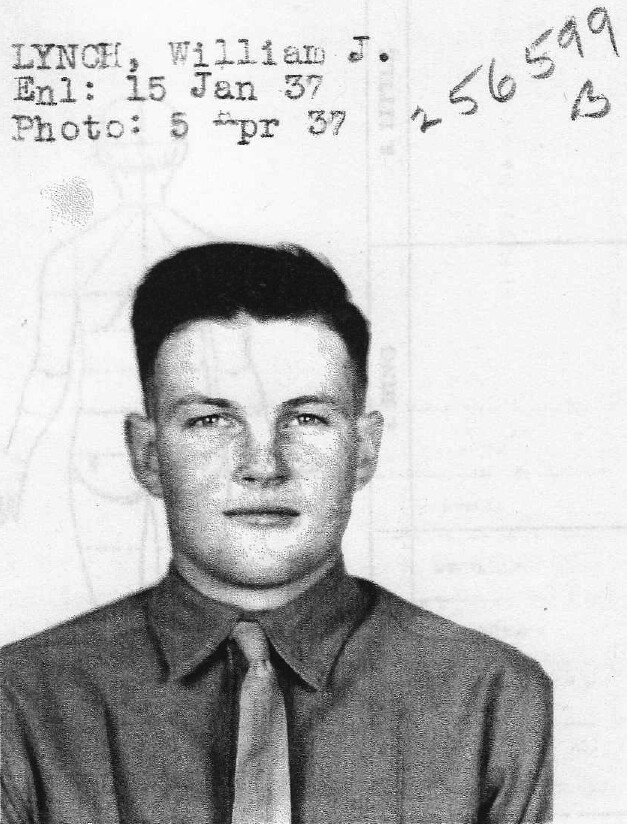| Hoten POW Camp (Mukden, China) |
Main Index Camp List Contact Us
|
The Mukden camp was located on the outskirts of the city (Hoten,
in Japanese; now Shenyang) and consisted of three additional and
separate factories where the men were used as slaves: Camp One: a tannery using over 150 men at all times Camp Two: A textile factory Camp Three: Combination steel and lumber mill Location: Shenyang WW2 Allied Prisoners Camp Site Museum (satellite map) Camp Reports - Mukden Temp Camp and Hoten Camp Capt. Mark Herbst Diary (RG 407 Box 53) - record of deaths, locations, causes Hansen and Herbst Camp Reports (MPOWRS) Hankins and Hansen Roster (RG 407 Box 130) Rescue Report - Time line and notes regarding the actual rescue Additional Research by Netherlands researcher, John Slootmaekers regarding Intl Red Cross Committee records: Letter, Int'l Red Cross
Committee, 19 June 1944 - Col. Genji Matsuda was Camp Commandant
Visit on 6 December 1944 by IRCC (letter IRCC 25 May 1945) Excellent website - Mukden Prisoner Of War Remembrance Society -- NOTE: This link no longer active; awaiting update. Joseph Goodman Notes (RG 407 Box 130) - chronology of journey via Oryoku Maru to Fukuoka #3 and Mukden The death of William Frising during evacuation Chronology (Timeline) of events related to Mukden POW Camp (Special thanks to Cynthia B. Caples, Public Affairs Officer, U.S. Consulate, Shenyang) John Henry Haigwood - military bio and background info on Corregidor Island Diary of Nicoll Galbraith (U.S. Army, GSC) - Gen. Wainwright's G-4, Logistics, staff officer. "Diaries are replete with literature, linguistics, languages, oenology, religion, recipes, letters home and other tangental subjects of his interests. The POW camps included Karenko and Shirakawa in Taiwan, Chang Chia Tung and Mukden." (Courtesy of Whitney Galbraith, author of Valley of the Shadow) Group photo (1a - 1b) of Oryoku Maru survivors - Can you help identify these men? |
Misc.
NARA
Documents
POW
roster (link no longer active)Evacuation Rosters (from Russians) MUKDEN Civilians, POW deaths (RG 407 Box 190) Folder 4: Information on Prisoner
of War and Civilian Internee Camps, Civilian Internees, Mukden,
Manchukuo. May, 1945 - Japan, Chosen, China. British, Canadian,
American, Dutch, Greek, Norwegian, Australian, New Zealanders,
South African, Palestinian, Belgian, Iranian, Indian, Chinese,
Cuban, Panamanian, Uruguayan, Costa Rican and other civilians.
POW payrolls
and deposits HOTEN (RG 331 Box 3959 - includes transfers
from Taiwan and Fukuoka camps; wage accountsFolders 10, 11: Mukden POW Camp - November 1942 to April 1945. Death List of Allied Personnel - American, British POWs. MUKDEN Signal Air Warning Co 429th Sig (RG 407 Box 122) Headquarters Camp Hoten, Mukden,
Manchuria and Basic Letters (Rosters). Roster of American
enlisted men and officers of Signal Air Warning Co.; 429th
Signal Maintenance Co. (Aviation)
MUKDEN
Hoten roster 1944-11-01 (RG 407 Box 122)Folder 7: Name List Hoten POW Camp
- November 1, 1944.
Includes American officers, chief warrant officers and enlisted men, British officers, chief warrant officers, non-commissioned officers, privates and civilians. Australian officers and enlisted men, Canadian officers and Dutch officers, chief warrant officers, non-commissioned officers, privates & civilians. MUKDEN Hoten transport lists; deaths (RG 389 Box 2121) Folder 18: Mukden Camp - List of
POWs DMs from Taiwan and Philippines, American POWs only.
Includes Lists DM 12 (November 14, 1944), 15 (March 28, 1945),
10 (October 14, 1944), 2, 3, 4, 5, 6, 7 and 8.
Folder 19: Death Lists - Mukden Camp, American JUs. Includes Lists JU 13, 11, 15, 24, 50 and 70. Unit 731 at Mukden Camp: Read Linda Goetz Holmes' book, Guests Of The Emperor -- The Secret History Of Japan's Mukden Camp (2010), for the story behind the secret tests done at the camp. See also US-Japan Dialogue on POWs' special webpage, Mukden POW Camp. Book by Arthur Christie - Story of British POW Downed airmen (photo - names) captured on Dec. 7, 1944, after bombing raid and held in nearby Mukden City Jail. All fourteen men were liberated at the end of the war. |
Diary and Asst. Papers of Col. Edmund Lilly, Commander of the 57th Philippine Scout Regiment (courtesy of Combined Arms Research Library through a donation by Col. Lilly's daughters)  A Prisoner's Prayer by Brig. Gen. Brougher (Shirakawa, Taiwan 1944) (from Edmund Lilly Diary, Poems and Songs) Roger Mansell 2008 visit to Shenyang and former site of Mukden POW Camp |
|
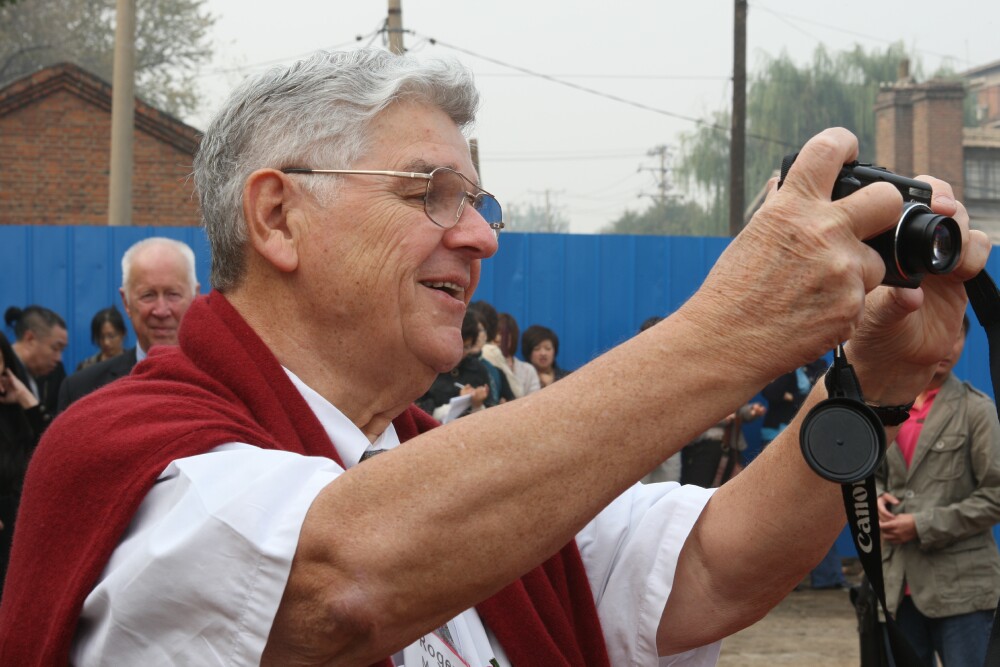 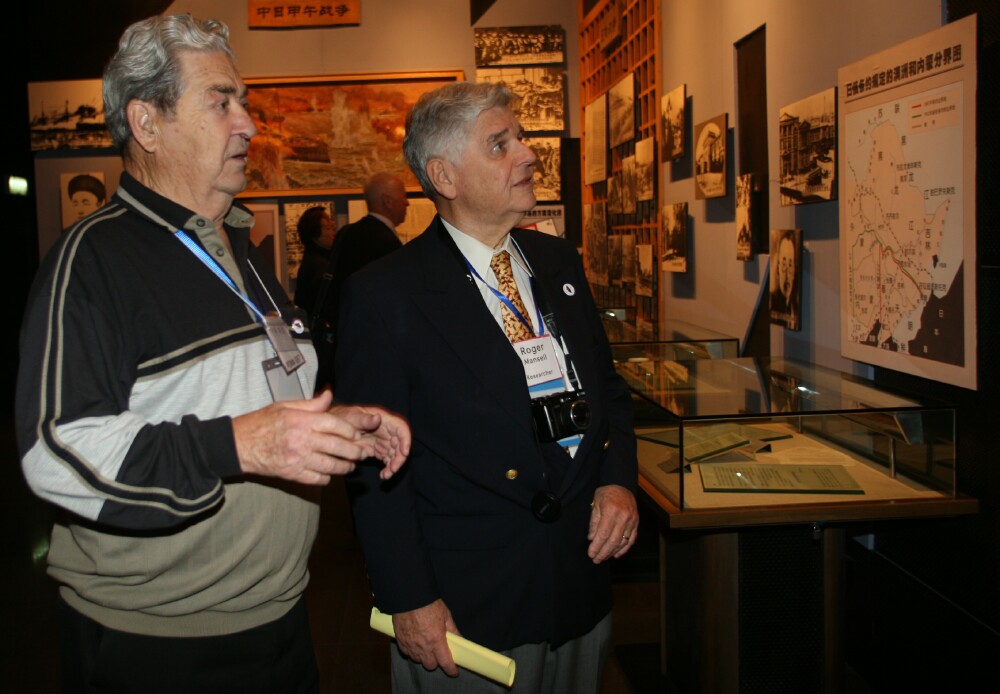 Mansell with Hersheal Boushey 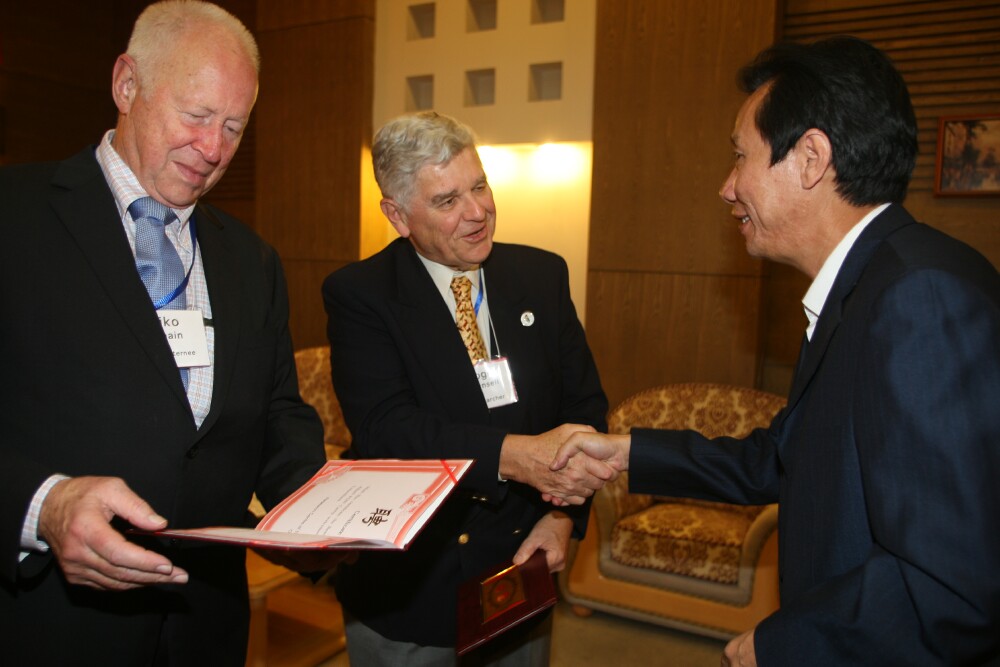 Mansell accepting fellowship |
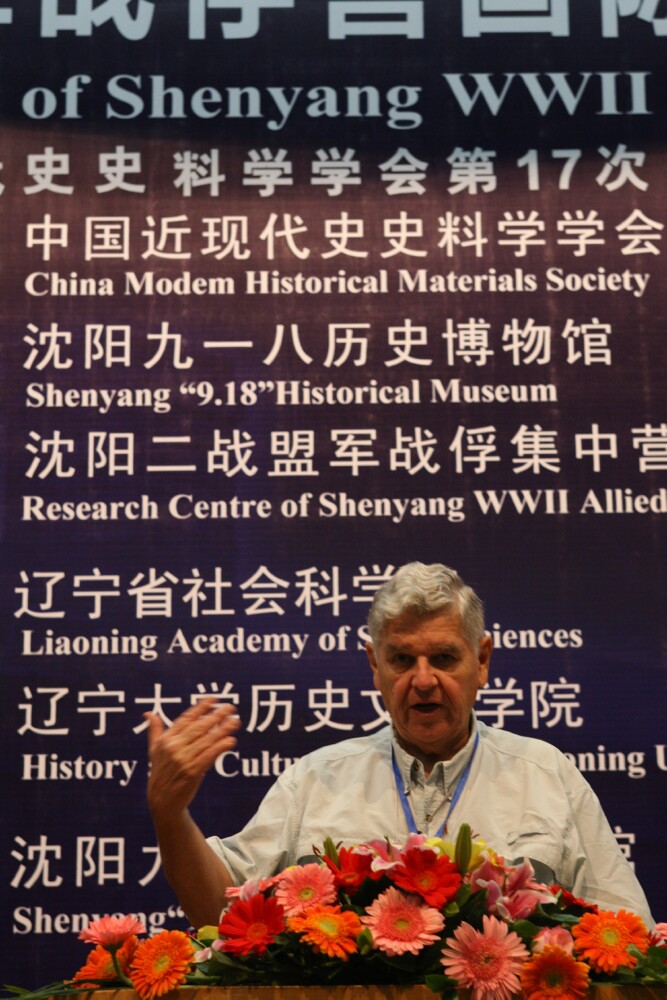 Researching Mukden - seminar speech, includes a good history of Roger Mansell's POW research work |
|
The following research is courtesy of Fred Baldassarre: Execution
of
Three Escapees
at Hoten Prison Camp S/1C Ferdinand F. Meringolo:
SA#233990, USS Canopus, New York
Sgt. Joe B. Chastain: SA# 270992 4th Marine Regiment, Company K, Texas CPL Victor Pallioti: SA# 274301, 4th Marines, Company D, Rhode Island On June 23, 1943, three POWs escaped from Hoten Prison Camp. Col. Matsuda, the Camp Commandant, said he was surprised that the three men escaped and that they would be severely punished. On or about July 10, they were, allegedly, captured by Mongolian farmers and police outside a small village near a place called Chengchiatun. Lt. Teru Miki, Superintendent of Camp Hoten, went to the "Mukden Gendarmarie" to identify the men. He described them as being very thin, weak and their bodies were covered with injuries received from blows by Mongolian farmers, who beat them with hoes, spades and other farm tools. Miki went on to say that they were bandaged and their wounds were treated by the Mukden Gendarmarie. Their escape was investigated by the Gendarmarie. They were arraigned and court martialed by the Kwantung Army in Mukden. Miki testified that, at their court martial, Chastain re-enacted the steps of the escape in great detail and he expressed remorse for having tried such a "crazy thing." The men also confessed to having killed a Mongolian policeman and injuring a member of the "Civilian Defense Corps." Their confession resulted in their death sentence. They were returned to the prison camp and kept in the prison camp stockade (a prison within a prison). In the early morning of July 31st, at approximately 5:30, they were taken to the POW cemetery accompanied by Medical Officer Kunishima. Lt. Teru, the commander of the Mukden Independent Garrison Unit, Gendarmarie Commander, Chief of the Army Prison, several judicial officers, a medical captain sent by the Kwantung Army and an execution squad comprised of a 2nd Lieutenant and six NCO rifle men. Hoten Commandant, Col. Matsuda, could not attend due to an illness. The faces of the three men wore covered with white cloths and then blindfolds were placed over their eyes. Their wrists were tied to the arms of wooden crosses and they were made to sit down folding their legs. The riflemen took kneeling positions seven or eight meters away from the men, one man aimed at their foreheads and another at the heart of each of the three men. The commander of the execution squad gave the order and six shots were fired at one time. A small quantity of blood spurted out from the white cloth covering the faces of the men and from the chest sections of the overalls the men wore. After the medical captain that had been sent by the Kwantung Army had examined them, the corpses were delivered to the camp. Their bodies were placed inside a coffin, then returned to the cemetery where they were buried in Plot 15: Graves #7, #8 and #9. Further punishment resulted for the escape. Thirty men were sentenced to ten days of "Heavy Confinement" in the camp stockade. Six of them, whom the Japanese claimed were accomplices, were questioned and beaten by Lt. Miki and Sgt. Noda. Sources: USA v. Teru Miki USA v. Genji Matsuda/Joichi Kuwashima Testimony given by Lt. Col. Stanley Hankins (USA v. Genji Matsuda / Joichi Kuwashima) In the evening of May 20, 1944, an electrical storm hit Mukden. Lightning hit the guard tower of the camp where the men who were transferred to the Leather Tanning Mill where billeted. In the ensuing chaos, fellow Mukden POW, Bob Branch, wrote Sgt. William J. Lynch managed to escape that night. It was an unsuccessful escape. The Kempeitai brought Lynch back into the camp on a stretcher, laying him down close to the gate. He looked to have been very badly beaten. (Some former POWs said he was shot. There is no proof he was shot.) He was almost unrecognizable from the beatings to his face and did not appear to be conscious. After some time passed, two guards picked up Lynch and took him out of the camp. That was the last time anyone saw Sgt. Lynch. One version of this story is Lynch died in captivity after being sent to Port Arthur…. Port Arthur, now called Lushun, is a town on the coast of Manchuria, approximately 272 miles from Mukden (Google Earth). The Kempeitai had their own prison there, one separate from the Japanese Army or the Principality of Manchuria. Manchurian researcher, Yang Jing, found two surviving witnesses who claim to remember seeing a Caucasian prisoner, who was around the same age Lynch. The Caucasian prisoner was said to have died and was buried in a nearby cemetery. It stretches the limits of credulity that the Kempeitai would move Lynch, who was already nearly dead, 272 miles to execute him. The most remarkable element in Sgt. Lynch’s story was the lack of any reaction of the commandant or Japanese guards in Mukden after Lynch’s escape and recapture. There was no retaliation or speeches expressing their indignation, as there was after the Meringolo, Chastain, and Pallioti escape. Life in the camp simply went on as if nothing had happened. Robert Wolfesberger (27th Bomb Group) stated that most of the former Mukden POWs only learned about Sgt. Lynch’s escape many years later, after the war, at their survivor’s reunions back in the US. The Japanese even kept Sgt. Lynch’s name in their rolls, as if he was still there. The only POWs who knew of Sgt. Lynch’s escape were the POWs who worked and lived in close proximity to him. Sources: Phone Conversations with Robert Wolfesberger, Roy Weaver and T. Walter Middleton. "Undaunted Valor" by Sheldon Zimbler Roger Mansell – Website Yang Jing – E-Mail Marie Daly, Massachusetts Geneology Society. Boston Public Library |
|
